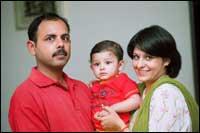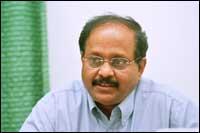|
|
| Help | |
| You are here: Rediff Home » India » Business » Special » Features |
|
| ||||||||||||||||||||||||||||||||||||||||||||
|
| ||||||||||||||||||||||||||||||||||||||||||||
 When Neha and Vivek Saxena decided to bank the cord blood cells of their baby more than a year ago as an 'insurance,' little did they realise that they would have to use it so soon.
When Neha and Vivek Saxena decided to bank the cord blood cells of their baby more than a year ago as an 'insurance,' little did they realise that they would have to use it so soon. Although their families did not have a history of any health problems, they decided to bank the stem cells of their baby.
"We did it for our child. But I took some time to be convinced mainly because it involved big money. I consulted my family doctor, my sister and father who are scientists, to know whether it was worth it. It is a kind of bio-insurance for our child," Neha explained the thoughts that went behind the decision.
Unfortunately, her son developed intolerance to milk from the fourth month onwards. "This has made him extremely vulnerable to diseases. My son is also anaemic, and is on antibiotics. I just hope and pray that some scientist would do some research on this area. I pray that the investment that we made will solve these issues. I feel this is the best insurance we have taken for our son."
Neha had post-delivery complications due to the negligence in the hospital, and a blood patch surgery on her back a week after the delivery has made the situation even worse. Now she has severe back pain, headache and many other health problems. "The only hope I have now for spinal injury is the stem cells of my son that we have banked. We are told a lot of research has gone into spinal injuries. What we had done for our child might come to use for me, I think. Strange!"
Stem cell bank
 S.Abhaya Kumar, the founder and managing director of Shasun Drugs and Chemicals, is the man behind India's first private stem cell bank, LifeCell. Marketing guru Dr Jagdish Sheth one of the directors of Shasun helped set up this project as Dr.Sheth was also on the board of Cryo-cell International Inc. in Florida, USA. Set up in 1992, Cryo-Cell International is the world's first and largest cord blood stem cell bank.
S.Abhaya Kumar, the founder and managing director of Shasun Drugs and Chemicals, is the man behind India's first private stem cell bank, LifeCell. Marketing guru Dr Jagdish Sheth one of the directors of Shasun helped set up this project as Dr.Sheth was also on the board of Cryo-cell International Inc. in Florida, USA. Set up in 1992, Cryo-Cell International is the world's first and largest cord blood stem cell bank.
"Dr Sheth was very interested in bringing the technology of preserving the stem cells from the (umbilical) cord blood for the family's future use. Since it had not come to India, we thought of this as a platform to do a lot of research," Abhaya Kumar said.
But he knew how difficult it would be to introduce something of this sort in India. "As I was aware of the mindset of the Indian doctors, I knew selling this concept to Indian public will be the most challenging job, more challenging than setting up a lab of international standards."
He went ahead with the idea and a lab was set up with an investment of Rs.12 crore (Rs 120 million) as per USFDA standards. He also set aside Rs 3 crore (Rs 30 million) for marketing the concept.
As his daughter-in-law was expecting her first child by November, they decided to race against time to set up the lab in just six months' time. On 14 November 2004, LifeCell, India's first cord blood cell banking was inaugurated. "We wanted my grandson to be our first customer! It was a massive effort, and we were happy that we could store my grandson's cord blood." The first enrolment happened on the 28th of November and the first collection on the 5th of December.
What are Stem cells?
Stem cells are master cells that act as the building blocks of our blood and immune systems. They can develop into white cells that fight infection, red cells that carry oxygen throughout the body and platelets that promote healing. This ability allows them to act as a repair system for the body, replenishing other cells throughout our lives. Stem cells are found in our bone marrow where they continue to regenerate cells.
What is cord blood?
It is the baby's blood that remains in the umbilical cord and placenta at the time of birth. Cord blood has a high concentration of stem cells. Stem cells in cord blood have a number of advantages over those from bone marrow. They are easier to obtain than stem cells from bone marrow. The collection of cord blood is a quick and painless procedure with no risk to the mother or the child. They also have the advantage of being available for transplant if ever needed as the they are stored in the labs.
More importantly, the cord blood stem cells are a perfect match for the child and his/her blood relations from whom it is collected, thus eliminating the difficult process of finding a matching donor and minimising the risks of rejection.
The Procedure
Once a pregnant woman enrolls herself with LifeCell paying an initial fee of Rs 27,000, she is given a kit. Post delivery, within ten minutes of cutting the umbilical cord of the baby, the blood is collected and stored in the bag provided in the kit. The kit is sealed and sent by courier to the stem cell storing facility in Chennai. Cord blood can be retained at room temperature for almost 36 hours.
Once it reaches the lab in Chennai, the cord blood is tested for all types of infectious diseases. Only if it is found to be safe, stem cells are processed from it. About 14 ml of stem cells are taken and stored at a temperature of -190 degrees. Every parent who has banked with LifeCell has to pay Rs 2900 every year for the safe keeping of the stem cells from cord blood. Though the stem cells belong to the child, the mother is the guardian of the stem cell till the child turns 21.
How successful are stem cells
So far, 6000 cases are reported globally where stem cell transplants have been successful. One of the first successes was the stem cell transplant in a woman paralysed by brain haemorrhage. Another successful case was of a South Korean woman paralysed for 20 years, walking again after scientists repaired her damaged spine using stem cells taken from cord blood.
In India, Adyar Cancer Institute and Apollo Speciality Hospital in Chennai, Tata Memorial Hospital in Mumbai, Apollo Speciality Hospitals, Global Hospitals, and NIIMS in Hyderabad, Christian Medical College in Vellore, Narayana Hrudayala in Bangalore, R&R Army Hospital and AIIMS in New Delhi, Inlaks Hospital and AFMC in Pune and Sanjay Gandhi PGIMS in Lucknow have stem cell therapy centres.
Ailments that stem cells can cure
Stem cells are already in use to cure ailments like acute leukaemia, chronic leukaemias, myelodysplatsic syndromes, stem cell disorders, myeloproliferative disorders, lymphoproliferative disorders, phagocyte disorders, inherited disorders like osteoporosis, B-Thalassemia, inherited metabolic disorders, inherited erythrocyte abnormalities like Beta Thalassemia mand Sickle cell disease, and other malignancies like multiple myeloma, plasma cell leukaemia, renal cell carcinoma and retinoblastoma.
Trials are on for cardiac diseases, diabetes, multiple sclerosis, muscular dystrophy, Parkinson's disease, spinal cord injury and stroke. Scientists are hopeful of stem cell applications in Alzheimer's disease, Lupus and rheumatoid arthritis in future.
Life Cell members
Life Cell has more than 1300 members. Some of the celebrity members are Raveena Tandon and Priya Dutt. So far, LifeCell has processed and stored around 1100 samples. Though it was expected that families with a history of cancer and other chronic ailments would enroll as members. Most of the 1300 members are using stem cell banking as an insurance for their child.
Dr. Prakash, who is a consultant psychiatrist with the Mahatma Gandhi Medical College and Research Institute in Pondicherry, decided to bank his first born's stem cells although no one in the family had any major illnesses. He and his wife had to think a lot before taking a decision, due to the high cost. As a doctor, I know the kind of unpredictability in everybody's life. I felt this will act like a buffer if something goes wrong not only for the child but others in the family too."
"We thought this would help not only the baby but the family as well. We felt this is an opportunity we are giving our child, which can help him in future," says Nilakandan and his wife Ameera.
The road ahead
Starting with one centre in Chennai, LifeCell plans to have centres in Gurgaon, Surat, Pune, Chnadigarh, Jallandar, Jaipur, Coimbatore, Nagpur and Vizag in India, and Dubai, Colombo, Kuala Lumpur, Singapore, Riyadh and Bangkok abroad, by the end of the year.
Abhaya Kumar does not want to restrict himself to cord blood banking alone. His plan is to have therapy centres also, and as a first step, LifeCell is collaborating with the Sri Ramachandra Medical Centre in Chennai to start a stem cell transplant centre. Initially, the hospital plans to have transplants in the cases related to haematology and oncology. "We plan to set up more transplant centres across the country in association with other reputed hospitals," said Abhaya Kumar.
LifeCell also intends to have application research and clinical trials with focus on spinal cord injuries and then move on to cardiac and other diseases. LifeCell has tied up with Saneron to bring in therapy for neurological disorders, to India.
"We are at par with the developed countries. I would say we are one step ahead in therapy, as in the US, there are restrictions they cannot use stem cells for all therapies. Approval takes a long time but in India, rules are more encouraging for research. So we would like to conduct of lot of clinical trials and establish procedures for therapy. Once we are successful in therapy, we can propagate all over the world," Abhaya Kumar said.
LifeCell plans to start a public cord blood banking facility. Every mother who supplies cord blood to the public banking has to give a declaration that the cells can be used for research or for third party use. This will be operational in another two months. If you want to take stem cells from a public bank, it will cost you Rs10 lakhs.
LifeCell gets 300 clients every month, and has a target to have 2000 clients every month. They plan to have 10,000 members by 2006-07 and 18,000 by 2007-08 and 30,000 by 2008-09.
Photographs: Sreeram Selvaraj
More Specials|
|
| © 2008 Rediff.com India Limited. All Rights Reserved. Disclaimer | Feedback |